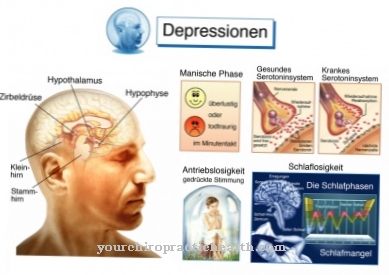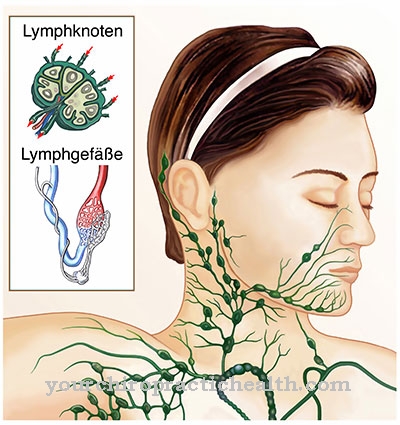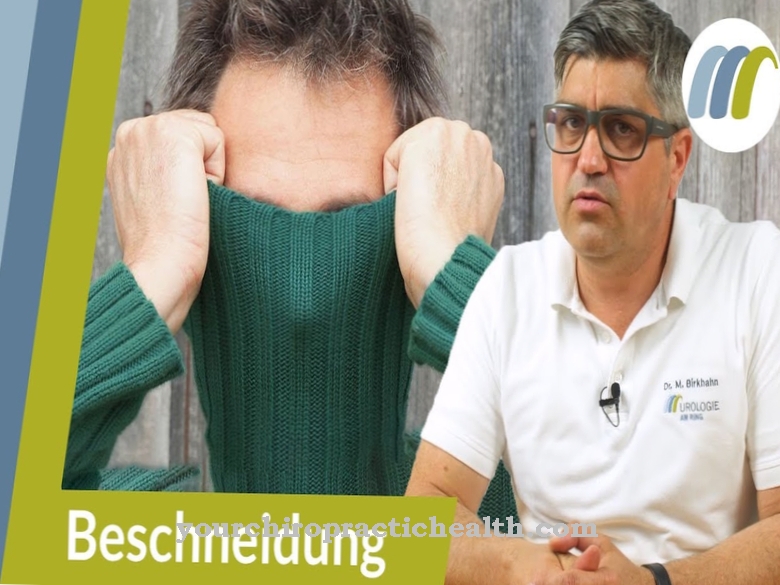Under Eardrum injuries (also: Eardrum perforation, Tympanic membrane rupture) ruptures (tears) and perforations (holes) in the tympanic membrane are summarized. Injuries to the eardrum are usually due to inflammation of the middle ear (otitis media) or direct or indirect violence.
What are eardrum injuries?

As Eardrum injury a rupture or perforation in the so-called membrana tympani (eardrum) is called, which protects the middle ear from external influences as a thin membrane. Injuries to this membrane manifest themselves in the form of stabbing pain in the area of the ear (especially in the case of ruptured eardrum), impaired hearing, slight ear bleeding in the event of a rupture of the eardrum and, if necessary, purulent otorrhea (ear flow) in the case of eardrum perforations.
Pathogens or foreign bodies that have penetrated through the damaged areas of the eardrum can also cause otitis media (middle ear infection) and lead to inflammatory reactions. Dizziness, nausea, vomiting as well as throbbing noises in the ears (tinnitus) and nystagmus (eye tremors) can result. In addition, an eardrum injury with an irritated inner ear can in some cases cause paralysis of the facial nerve (nervus facialis).
causes
Injuries to the eardrum are usually due to barotraumas (detonations, blows to the ear with the flat of the hand, disturbed pressure equalization when flying or diving), direct damage to the membrane from pointed or blunt objects (cotton swabs, hairpins), infections (otitis media) or iatrogenic causes ( improperly performed ear irrigation).
Excessive force on the ear can also lead to damage to the middle ear (damage to the auditory ossicle) and possibly the inner ear. In addition, burns (sweat bead injury) and chemical burns can damage the membrana tympani.
A longitudinal petrous bone fracture (form of a skull base fracture) is also associated with a rupture of the eardrum in many cases. If the eardrum has already been injured, the risk of a new rupture or perforation is increased.
Symptoms, ailments & signs
An eardrum injury usually only affects one ear. The fact that both hearing organs are attacked to the same extent is an exception. In addition to acute complaints, consequential damage can occur if treatment is delayed or not treated. The most common symptom is a pain in the ear. This occurs during or shortly after the injury.
However, it goes out after a few seconds. In rare cases, it is accompanied by a small amount of blood leakage from the ear. An acute illness usually causes small tears in the eardrum. Those affected do not perceive any recognizable hearing loss afterwards. On the other hand, if the ossicles are damaged, permanent impairment of hearing is possible.
In addition to the direct symptoms on the ear, the body sometimes rules with other complaints. Those affected then complain of dizziness. Sometimes nausea also occurs. The eyes move back and forth quickly. For extensive injuries, doctors regularly diagnose otitis media. Facial paralysis can also develop.
An eardrum injury can lead to permanent hearing loss. For example, patients can no longer clearly understand conversations in a noisy environment. Constant noises in the ears accompany everyday life. In the worst case scenario, this impairment of hearing can develop into deafness.
Diagnosis & course
In many cases a suspicion arises Injuries to the eardrum already from the anamnesis as well as the description of the course of the accident and the specific symptoms present. The diagnosis is confirmed by means of an otoscopy (otoscopy) and / or an ear microscopic examination. A hearing test enables statements to be made about conductive hearing loss (hearing loss), impairments of the inner and middle ear and damage to the ossicles.
If the injury is the result of violence from objects or liquid metal, an X-ray examination may be indicated in order to localize residual foreign bodies or foreign body parts.
As a rule, ruptures and perforations of the eardrum have a good prognosis and heal without complications. Pronounced eardrum injuries with inner and / or middle ear involvement can lead to irreversible hearing loss or deafness.
Complications
Direct eardrum injuries can damage the ossicle. It is responsible for transmitting the sound from the eardrum to the inner ear. A dislocation of the ankle is also not uncommon. This is a joint injury that often results in a joint capsule tear.
Hearing is severely restricted, which often results in deafness. Middle ear infections are one of the most common complications: If it is acute, it is particularly painful as it progresses and leads to pulsing, throbbing and ringing in the ears that further cloud the hearing. Fever, nausea and vomiting set in with a more severe inflammation.
There is also the risk of perforating the medial wall of the tympanic cavity, the cavity in the middle ear that is located directly behind the eardrum. It is responsible for equalizing the pressure in the ear. It is not uncommon for meningitis to occur when the tympanic cavity has been affected. Bacteria, viruses and fungi lodge in the injured tissue and this can lead to cramps, photophobia and apathy.
Labyrinthitis is also often the result. The labyrinth of the inner ear becomes inflamed and the entire duct system is negatively affected. In the worst case, pus forms, which leads to numbness if the course is severe.
When should you go to the doctor?
If the eardrum is injured, a doctor should always be consulted. If you experience pain in the ear canal or your hearing suddenly deteriorates, medical advice is needed. If blood runs out of the ear canal, it is best to see an ear specialist immediately. An injury to the eardrum must be clarified and treated in order to avoid restrictions in everyday life and to rule out complications such as an infection of the middle ear. Increasing earache or purulent secretion around the ear indicate an injury that needs to be investigated. If the symptoms arise after attending a concert, the eardrum may have torn.
The audiologist can diagnose the condition using an otoscope and initiate further measures. This should be done as early as possible to avoid further hearing impairment. If the eardrum is damaged in an accident, the emergency services must be called. The ears can be carefully cleaned beforehand. People who expose their ears and ear canals to great stress should visit a specialist at regular intervals.
Treatment & Therapy
The therapeutic measures are attached Injuries to the eardrum on the severity of the damage. Small injuries usually heal on their own within a few days without the need for treatment.
During the convalescence phase, however, the affected ear should be kept dry by protecting it, for example, with an ear bandage or cotton wool while showering or bathing. If an eardrum perforation is diagnosed as a result of otitis media, decongestant nose and / or ear drops and antibiotics are also used. If an eardrum rupture is characterized by rolled-up or rolled-up injury edges, these are tightened and the affected eardrum is splinted with a silicone sheet to ensure that the edges grow together smoothly.
If the injury does not heal after a few weeks (4 to 6), surgical closure is required to restore sound conductivity. For this purpose, the natural shape of the eardrum is reconstructed as part of a myringoplasty by replacing the imperfections of the ruptured or perforated eardrum with adjacent tissue (fascia, cartilage, cartilage skin).
Smaller imperfections can be replaced by the body's own fatty tissue. As a rule, injuries to the middle and / or inner ear (damage to the ossicles) can be repaired at the same time as this procedure (tympanoplasty). Following the reconstruction, the eardrum is stabilized using a silicone film.
You can find your medication here
➔ Medicines for earache and inflammationprevention
A Eardrum injury cannot be prevented in every case. However, with appropriate hearing protection, barotrauma as a result of detonations can be prevented. By not cleaning the ear canal with cotton swabs or other sharp objects, damage to the eardrum can be avoided.
If you have a cold or otitis media before a flight or a dive, these should be avoided. The so-called Valsalva maneuver (forced exhalation with closed nose and mouth openings) minimizes the risk of eardrum injury during take-off and landing when traveling by plane.
Aftercare
Injuries to the eardrum can regenerate well with consistent follow-up care. Competent contacts in this context are the ENT doctor or the hearing aid acoustician. A check-up by a doctor ensures that the injury will heal optimally. The doctor determines the frequency and frequency of the check-ups.
The patient is also responsible for the success of the follow-up care with his cooperation. So it is important to avoid any pressure on the eardrum during the healing phase in order to prevent another rupture. Diving is a sport that should be avoided during the aftercare phase due to the pressure on the eardrum. Air travel can also overload the eardrum and should be undertaken in consultation with the doctor.
In order to prevent particles from getting into the ear canal in the event of a leaky ear drum and contaminating it, protective measures are also advisable during aftercare. So when washing your hair and showering, no water with shampoo residues should get into your ears. Anyone who has poor hearing due to an eardrum injury or who has tinnitus as a symptom should deal with it patiently and neither overstrain themselves professionally nor privately during the follow-up care.
Those who prefer to read a book in peace and quiet and do without music can often support regeneration in the case of eardrum injuries.Anyone who suspects hearing damage can easily clarify this with the hearing aid acoustician with a hearing test.
You can do that yourself
Mild illnesses usually do not require any further treatment. Small cracks close by themselves. Those affected benefit from the self-healing power of the eardrum. You can, however, help recovery by taking it easy and avoiding loud ambient noises.
The ear must also be kept dry. It is recommended that you use moisture-repellent cotton when showering. Shampoos must not get into the ear canal. You can tear open wounds again due to the preserved substances. Self-help measures are generally not advisable if complications such as blood flow, pain or hearing loss arise. Patients can use over-the-counter nasal drops to help speed recovery. This improves the ventilation of the ear canal. A pharmacist will advise on suitable preparations. In addition, exercise should be avoided after an acute illness. The patient should not lie on the diseased ear at night. In winter, a hat or headband should be worn when walking in the fresh air.
Workers in noisy environments are particularly affected by eardrum injuries. You should definitely use hearing protection. This preventive measure is the best way to prevent illness. The employer is obliged to provide protective equipment.



.jpg)























